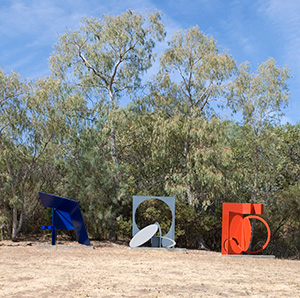

Bay Area sculptor and longtime SJSU art professor (1967-’86) Fletcher Benton is primarily known for his abstract metal works. They look best fitted into landscapes with long sight lines—monuments designed to catch the eye of sculpture-garden strollers.
As shown in an exhibit at Santa Clara University’s de Saisset Museum, Benton thinks big by starting small. “Fletcher Benton: The Artist’s Studio” provides a glimpse of his working method, which begins with the deceptively simple act of tinkering.
With wall-size photographs, a re-creation of his cluttered workbench (complete with work gloves, tape measure and pliers) and samples of his maquettes, the exhibit details Benton’s restless process of assembling simple shapes into complex constructions.
Miniature mock-ups for an outdoor installation in Cologne feature polished steel cones, cubes, rods, spheres and hoops welded together in exploratory iterations. There are no moving parts, but Benton’s eye for exact equilibrium points gives the shiny objects a sense of impending action, as if they were Rube Goldberg machines just waiting for the on/off switch to be flipped. At times, they bristle with projecting tubes like the barrels of futuristic weaponry.
A study titled Spring It No. 121 cradles a cylinderlike part in a circular band of steel that ends in a tight coil; the implied potential energy of the coil threatens the exquisite poise of the piece—a good whack might set off destabilizing oscillations. Benton confines himself to a relatively small repertoire of basic building blocks, although he occasionally inserts a surprising chunk of literalism in the form of a tiny ladder.
When the artist settles on a perfect arrangement, he scales it up to full size with the help of a blow-torch-wielding assistant. The final sculptures, as seen in photographs, are often painted in bright colors. The two large pieces in the lobby of the museum, however, are matte steel and copper-colored.
In Plane to Edge: Two Balls (1997) a huge rectangular slab perches on top of a bowling ball-size sphere in a balancing act that seems impossible; why doesn’t it tip over? Unfortunately, the big works feel cramped; they need to breathe in the great outdoors.
The downstairs gallery delves deeper into Benton’s oeuvre with “Fletcher Benton: In Motion,” a heady selection of his kinetic sculptures from the 1960s and ’70s. Motorized metal frames encase panels of translucent, colored Plexiglas. Slowly moving atop one another, the panels act as animated color wheels, changing hues in hypnotic fashion. Adding to the effect, the panels cast wispy colored shadows on the walls.
In Black Continuous Radius Triangle (1965), blue and yellow wedges rotate on overlapping discs, creating an endlessly morphing array of subtle tones. Rock & Roll (1964) doubles down on the idea. A disk with a metal frame rolls back and forth along a shallow, curved metal track. With a satisfying low-tech click, a small motor in the base imparts, just enough tilt to the track to maintain the motion. The steady if somewhat herky-jerky motion keeps the Plexiglas color wheels inside the disk rotating as well. It’s better than a lava lamp for pure contemplation or zoning-out, which were pretty much the same thing in the ’60s.
Cylinder With Red Circle (1965) looks like a machine to demonstrate some forgotten scientific phenomenon. A thick polished-metal cylinder mounted on a geared base turns slowly on its axis while an opaque red disk rotates ever so slowly on one end.
Running concurrently, the group show “Reduce, Reuse, Re-imagine” explores the possibilities of discarded materials in art as both aesthetic and social statement.
Two works stand out. For Invasion (2013), Cathy Suzuki cuts up clear and green plastic bottles into underwater shapes—jellyfish, squid and the like—and hangs them in a ceiling-to-floor mobile. The work not only uncannily evokes marine life but also highlights the so-called “plastic soup” of floating trash that represents an environmental threat to ocean creatures.
Sudhu Tewari’s Green Apples (2007) comes straight from a scavenger/mad scientist’s lab. A variety of springs protruding from an upside-down colander are free for the plucking. The resulting vibrations can be heard on speakers and seen on an old-school computer monitor, whose green screen displays various wave patterns in response to the twanging springs.
Tewari calls himself an “audio-gadgeteer,” and the piece might be titled Frankenstein’s Stumpf Fiddle—proof positive that recycling isn’t just good for the conscience, it’s sheer fun as well.
Fletcher Benton: The Artist’s Studio and in Motion
Run through Dec. 6
Reduce, Re-Use, Re-Imagine
Run through Dec. 6 and Jan. 10-Feb. 2
Both at de Saisset Museum


